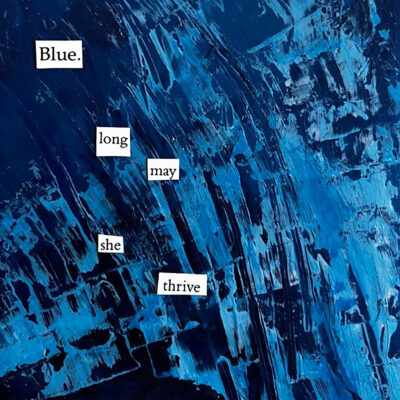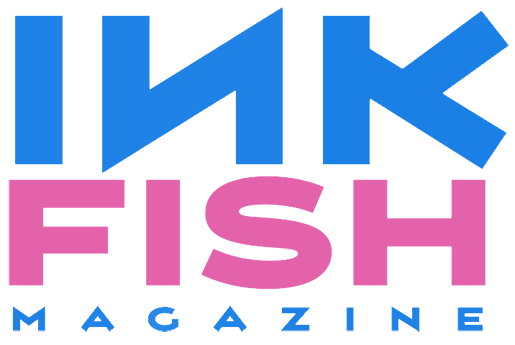Interview with D. Parker
author & artist
Questions by Kate Horsley
Tell us a bit about yourself!
I’m a writer, artist and bookseller living in the UK.
When did you first start writing and what were the first projects you worked on?
I started writing in 2019, and had my first piece published in 2020! I started writing poetry, but my first published piece was a personal essay about Orlando and Virginia Woolf. I love myths/folklore and art, and my early pieces were inspired by Greek myths and art.

As your writing has evolved, what has changed the most?
Everything! When I started writing, my poems were traditional in form, but as I read more and grew more confident, I started to experiment. I look back some of my early work and I feel like it was written by a different person! The things that changed most in my writing though, are, I think, structure and form. I love language and I’m interested in how type occupies the page, on how the negative space around the text influences the reader’s understanding of it, and how the format in which the text is presented complements its subject.
Your work combines textual and visual elements in a bold and experimental way that feels very compelling to look at as well as to read. How did you come to work on this borderline between text and image?
Thank you! That’s so kind of you to say. I went to a fine arts high school, which has a huge impact on how I approach any sort of visual work, from sketching to collage and concrete poetry. We were always encouraged to experiment with pretty much anything and everything we could get our hands on. The school had a traditional approach to technique, and a lot our lessons were focused on colour theory, perspective, contrast, volume, composition. The blend of text and image came much later, but studying art for four years allowed me to build a strong foundation. Sometimes I find it hard to express what I want or need in words, so a picture—or some kind of graphic/visual element makes more sense to me and helps me (hopefully) to get my point across.
Can you describe your process? Are there things in your environment that especially inspire your process?
I have a scattered way of approaching my work, and I often jump from one project to another. I tend to overthink everything, so a simple 10 minute sketch is often the result of an hour of staring at a blank page or looking through my art books or comics/manga for inspiration. I find that if I’m stuck in one media or genre, it helps to switch to something else and carry on working. I love going to museums and art galleries and take a lot of inspiration from my collection of art books, comics and manga. I love traditional tattoos and when I get especially stuck on something I’ll paint a quick traditional rose. And if that doesn’t work, I’ll sketch a section of a cube, which usually does the trick. I love cutting sections in cubes because they challenge me to see a rigid shape in a new way. I have a different process for writing and tend to write in bursts. I don’t read during these bursts. I write every day for a couple of weeks and then come to a sudden stop—when this happens, I read anything I can get my hands on. And a few weeks later, I write again. I’m fascinated by the natural world, and a lot of my recent work centres around the folklore and lives of plants and animals.
Click for a larger image.
Which books, authors and images do you return to the most for inspiration? Who are your biggest influences?
Virginia Woolf! Woolf’s writing is a huge influence on my work. Orlando is my favourite book; I discovered it when I started figuring out my sexuality, and I can’t think of another book that has had the same or greater impact. I read it many times, and I often open it to a random page just to clear my eyes a little. I always carry a copy with me. Another book I consider influential is House of Leaves by Mark Danielewski. Since you recommended it in one of our meetings, I couldn’t stop thinking about it – I have two of the four(?) editions! Danielewski’s use of structure, typography and layout as means of storytelling is fantastic. House of Leaves – alongside Everything, Everywhere, All At Once – was crucial in the development of my MA portfolio project, Swift. I’m bilingual, and I love reading authors who weave words from their native languages into their work, as well as works in translation. There are so many other writers I read or reread often, like Anne Carson, Mary Jean Chan and Caroline Bird. Some of my favourite artists are Georgia O’Keeffe and Salvador Dali – I especially love the composition of Dali’s paintings.
You’re the founder and editor of the amazing Needle Poetry, which we love! Can you tell us a bit about how you came up with the idea for Needle?
Thank you! Initially Needle Poetry was going to be a magazine focused on short poems, but as I started developing the idea, I shifted its focus to experimental and hybrid work. I think there’s a need for more platforms which encourage writers and artists to experiment and just play around with ideas and techniques. Defining experimental writing or work is tricky though, I think, because what is experimental to one is completely traditional to another.
What is it like running a literary magazine? What do you love most about it and what are some of the challenges?
It’s exciting! I love seeing new work from writers and artists I admire and I love discovering new (to me) writers and artists! Working on the first two issues has introduced me to so many brilliant voices and techniques. I think my favourite part about running a literary magazine is learning from people. It’s so interesting seeing how people use language, visual elements and structure/form in their work. One of the biggest challenges, for me, is when submitters don’t read the guidelines or research the magazine. I’ve had to reject some brilliant work because it didn’t fit Needle’s guidelines.
Recently, there seems to have been a resurgence of work in vispo and concrete poetry that feels reminiscent of Dadaism and/or the Oulipo movement in some ways. If you agree with that statement, what do you think the reason for this might be?
I think this is to do with people’s desire to explore more art forms and new ways of shaping their ideas. Dada and the Oulipo movement both emerged as a rejection of the norm and offered a new kind of creative freedom and new sets of rules. Although vispo and concrete poems may require a slightly different kind of approach compared to more traditional poetry, you’re still working with the same elements (rhythm, contrast, imagery, line breaks) they’re just displayed in a different way. I think this is part of why we’re seeing so much of it at the moment: it’s a different playground for people to access, and who doesn’t like discovering new techniques and new ways of developing their craft? I think it’s wonderful to see this resurgence of visual poetry and concrete poetry and hybrid pieces. It’s wonderful to see poets and artists working outside their comfort zones and/or finding new types of comfort zones. It’s just wonderful to see work that challenges me as a viewer/reader and pushes me to think of new ways of approaching my own work.
Hybrid image/text work walks a tightrope between what words mean and their visual impact. How do you feel the collision of these two art forms alters a reader/viewer’s understanding of both?
I love this question! I think hybrid image/text work is brilliant because it blends two types of reactions: instantaneous and delayed. I see any kind of image or visual work as demanding a sudden reaction from the viewer. You see an image and immediately have an idea or reaction to it, whichever that may be. With text, you have to take time to process what you’re seeing. When I look at a hybrid piece, I always have the initial reaction to the image at the back of my head, which I think influences how I perceive the textual element.
What is the most experimental piece or series you’ve ever created?
There are two! I love our ‘blue’ project and the way it pushes me to develop my craft. It’s so playful and refreshing to work on a prompt and to have the freedom to pick the medium and the style. The other experimental series I worked on is Swift, which is a retelling of the same event in different styles and techniques. Writing Swift is like being on a huge playground. I think the only rule I set for myself is to keep the ‘chapters’ around 5-600 words. The project incorporates everything from traditional prose to choose-your-own-adventure, to prose poems and concrete poems. I’m currently working on a crossword puzzle chapter but I’m still trying to figure out how to structure that!
What are you working on at the moment?
A couple of things! I’m working on a poetry pamphlet about Medea, I’m looking into art theft and forgery in history for another project, another poetry pamphlet about eels and a longer hybrid project on queer identity.
About D. Parker
D. Parker has a keen interest in experimental writing and has an MA in Creative Writing. Her debut pamphlet Rush was published by Bullshit Lit Mag + Press in February 2023. Find D. Parker and Needle Poetry on Twitter






